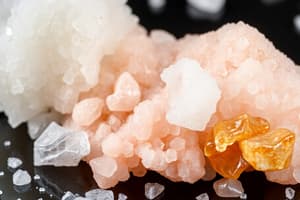Podcast
Questions and Answers
Which of the following best defines Inorganic Chemistry?
Which of the following best defines Inorganic Chemistry?
- The examination of chemical reactions involving only gases.
- The study of carbon-containing compounds and their properties.
- The branch of chemistry focused exclusively on organic compounds.
- The branch of chemistry dedicated to studying inorganic compounds like minerals and metals. (correct)
Which test is commonly used to identify cations in salt analysis?
Which test is commonly used to identify cations in salt analysis?
- Thermal decomposition.
- Flame test. (correct)
- Titration method.
- Acid-base indicator test.
What does a positive result in a dilute acid test indicate about the presence of carbonates in a salt?
What does a positive result in a dilute acid test indicate about the presence of carbonates in a salt?
- Carbon dioxide gas is evolved upon reaction. (correct)
- The solution will change color drastically.
- No reaction will occur, indicating a neutral salt.
- The carbonate will precipitate when acid is added.
Which group of cations undergo solubilization tests in cation testing?
Which group of cations undergo solubilization tests in cation testing?
In salt analysis, which of the following tests is used to confirm the presence of sulfate ions?
In salt analysis, which of the following tests is used to confirm the presence of sulfate ions?
What is the significance of confirming test results in salt analysis?
What is the significance of confirming test results in salt analysis?
Which of the following statements about transition metals is true?
Which of the following statements about transition metals is true?
Which safety precaution is essential when conducting salt analysis tests?
Which safety precaution is essential when conducting salt analysis tests?
Flashcards are hidden until you start studying
Study Notes
Inorganic Chemistry
- Definition: Branch of chemistry focused on inorganic compounds, which include minerals, metals, and nonmetals.
- Key Areas:
- Coordination Compounds: Involves central metal atoms bonded with ligands.
- Transition Metals: Elements that exhibit variable oxidation states and colorful compounds.
- Main Group Elements: Reactivity and properties of metals (alkali, alkaline earth) and nonmetals (halogens, noble gases).
- Oxidation States: Concept of charge on an atom in a compound which affects reactivity and bonding.
- Acid-Base Chemistry: Involves acids (proton donors) and bases (proton acceptors) and their reactions.
Salt Analysis
-
Purpose: Identification of ions present in unknown salts through qualitative analysis.
-
Types of Ions:
- Cation Analysis:
- Common Cations: Na⁺, K⁺, Ca²⁺, Mg²⁺, Fe²⁺/Fe³⁺, Cu²⁺, Ag⁺, Pb²⁺.
- Tests: Flame test, precipitation reactions, and color changes.
- Anion Analysis:
- Common Anions: Cl⁻, Br⁻, I⁻, SO₄²⁻, CO₃²⁻, NO₃⁻.
- Tests: Acidification, precipitation with barium or silver salts, and gas evolution.
- Cation Analysis:
-
Methodology:
- Preliminary Tests:
- Conduct preliminary examinations (solubility, color, etc.) to categorize the salt.
- Cation Testing Sequence:
- Group I: Solubilization tests for alkali metals.
- Group II: Precipitation tests for alkaline earth metals.
- Group III: Identification of transition metals through characteristic reactions and colors.
- Preliminary Tests:
-
Safety Precautions: Always use gloves and goggles when handling chemicals; conduct tests in a well-ventilated area.
-
Common Procedures:
- Dilute Acid Tests: Reacting the salts with dilute acids to identify carbonates and sulfides.
- Flame Test: Observing the color produced by the salt when heated in a flame to infer the presence of certain metal ions.
-
Confirmatory Tests:
- Follow up initial tests with confirmatory tests to validate presence and type of ions, often specific to each ion.
-
Reporting Results: Document findings clearly, specifying the method used and the ions identified based on color changes and precipitate formation.
Inorganic Chemistry
- Study of compounds that don't primarily contain carbon-hydrogen bonds.
- Focuses on elements like metals, minerals, and nonmetals.
- Important areas include coordination compounds, transition metals, and main group elements.
Coordination Compounds
- Metal atoms bonded to molecules or ions called ligands.
Transition Metals
- Exhibit variable oxidation states.
- Often form colorful compounds.
Main Group Elements
- Alkali metals, alkaline earth metals, halogens, and noble gases.
- Properties and reactivity vary depending on their position on the periodic table.
Oxidation States
- Charge on an atom in a compound.
- Determines reactivity and bonding behavior.
Acid-Base Chemistry
- Acids donate protons (H⁺).
- Bases accept protons.
- Their reactions form salts and water.
Salt Analysis
- Identifying unknown salt components through qualitative analysis.
Cation Analysis
- Common cations: Na⁺, K⁺, Ca²⁺, Mg²⁺, Fe²⁺/Fe³⁺, Cu²⁺, Ag⁺, Pb²⁺.
- Tests often involve:
- Flame Test: Specific colors indicate certain metals.
- Precipitation Reactions: Formation of insoluble compounds.
- Color Changes: Solutions change color when reacting with particular reagents.
Anion Analysis
- Common anions: Cl⁻, Br⁻, I⁻, SO₄²⁻, CO₃²⁻, NO₃⁻.
- Tests often involve:
- Acidification: Reaction with acids to produce gases or precipitates.
- Precipitation with Barium or Silver Salts: Indicates presence of specific anions.
- Gas Evolution: Bubbles indicate certain anions.
Methodology
- Preliminary Tests: Initial observations (solubility, color, etc.) to categorize the salt.
- Cation Testing Sequence:
- Group I: Alkali metals.
- Group II: Alkaline earth metals.
- Group III: Transition metals.
- Safety Precautions: Wear gloves and goggles, perform tests in a well-ventilated area.
Common Procedures
- Dilute Acid Tests: Acid reacting with salts to identify carbonates and sulfides.
- Flame Test: Heating salts in a flame to observe distinctive colors.
Confirmatory Tests
- Validate initial test results.
- Specific reactions for each ion to confirm its presence.
Reporting Results
- Document findings clearly.
- Indicate methods used and identified ions based on color changes and precipitate formation.
Studying That Suits You
Use AI to generate personalized quizzes and flashcards to suit your learning preferences.




